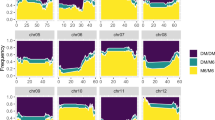Summary
Six Brassica napus — B. nigra disomic addition lines were characterized by isozyme, fatty acid, and RFLP markers. The markers were arranged in six synteny groups, representing six of the eight chromosomes present in the B. nigra genome. Synteny group 1 displayed high levels of linoleic and linolenic acids in the seeds of the B. nigra parent. Synteny group 3 accumulated higher levels of eicosenoic and erucic acid than B. nigra. Three of the lines transmitted the alien chromosome to 100% of the progeny. The rest had variable transmission rates but all were above 50%. Most of the lines produced disomic addition plants in their progeny, suggesting pollen transmission of the alien chromosome. In addition to the marked lines, six others remained unmarked. These could be grouped into two classes according to their alien chromosome transmission. It is likely that they represent the two other B. nigra chromosomes that remained uncharacterized by the markers. No diploid individuals carrying B. nigra genome-specific markers were detected in the progenies studied.
Similar content being viewed by others
References
Arus P (1989) Linkage analysis of isozyme genes in Brassica oleracea. In: Quiros CF, McGuire PE (eds) Proc 5th Cruciferae Workshop, University of California, Davis, p 45
Arus P, Orton TJ (1983) Isozyme and linkage relationships of isozyme loci in Brassica oleracea. J Hered 74:405–412
Attia T, Busso C, Röbbelen G (1987) Digenomic triploids for an assessment of chromosome relationships in the cultivated diploid Brassica species. Genome 29:326–330
Bachacou J, Masson JP, Miller C (eds) (1981) Amance 81. Department of Biometry, Publ INRA, pp 1–516
Bernard M (1976) Etude des caractéristiques cytologiques, morphologiques, et agronomiques de six lignées d'addition blé-seigle. Ann Amel Plant 26 [1]:67–91
Chang R, Tai W, Fan Z (1987) Cytogenetic studies of aneuploids in rapeseed. 2. Morphology, fertility, and cytology of self-pollinated progenies of monosomic plants of Brassica napus L. Genome 29:174–179
Delseny M, McGrath JM, This P, Chevre AM, Quiros CF (1990) rDNA genes in diploid and amphidiploid Brassica and related species: organization, polymorphism, and evolution. Genome (in press)
Downey RK, Harvey BL (1963) Methods of breeding for oil quality in rape. Can J Plant Sci 43:271–275
Fantes JA, Mac Kay GR (1979) The production of disomic addition lines of Brassica campestris. Cruciferae Newslett 4:36–37
Feinberg AP, Vogelstein B (1983) A technique for radiolabelling DNA restriction endonuclease fragments to high specific activity. Ann Biochem 132:6–13
Hosaka K, Kianian SF, McGrath JM, Quiros CF (1990) Development and chromosomal localization of genome-specific DNA markers of Brassicae and the evolution of amphidiploids and n = 9 diploid species. Genome 33:131–142
Jahier J, Chevre AM, Tanguy AM, Eber F (1989) Extraction of disomic addition lines of Brassica napus — B. nigra. Genome 32:408–413
Kaneko Y, Matsuzawa Y, Sarashima M (1987) Breeding of the chromosome addition lines of radish with single kale chromosome. Jpn J Breed 37 [4]:438–452
Kondra ZP, Thomas PM (1975) Inheritance of oleic, linoleic, and linolenic acid in seed oil of rapeseed (B. napus). Can J Plant Sci 55:205–210
Laakso I (1986) An analytical and breeding study on fatty acids in summer turnip rape. J Agric Sci Finland 58:103–141
McGrath JM (1989) Generation of monosomic alien addition lines in Brassica and their use in comparative evolutionary studies. PhD thesis, University of California, Davis
Quiros CF (1987) Duplicated isozyme loci and cellular compartementation of their products in Brassica. Cruciferae Newslett 12:24
Quiros CF, McHale N (1985) Genetic analysis of isozyme variants in diploid and tetraploid potatoes. Genetics 111:131–145
Quiros CF, Ochoa O, Kianian SF, Douches D (1986) Evolutionary trends in Brassica: gathering evidence from chromosome addition lines. Cruciferae Newslett 11:22–23
Quiros CF, Ochoa O, Kianian SF, Douches D (1987) Analysis of Brassica oleracea genome by generation of B. campestrisoleracea chromosome addition lines: characterization by isozymes and rDNA genes. Theor Appl Genet 74:758–766
Quiros CF, Ochoa O, Douches D (1988) Exploring the role of the x=7 species in Brassica evolution: hybridization with B. nigra and B. oleracea. J Hered 79:351–358
Raynal M, Depigny D, Cooke R, Delseny M (1989) Characterization of a radish nuclear gene expressed during late seed maturation. Plant Physiol 91:829–836
Raynal M, Depigny D, Grellet F, Delseny M (1991) Characterization and evolution of napin genes in radish and related crucifers. Gene (in press)
Reed KC, Mann DA (1985) Rapid transfer of DNA from agarose gels to nylon membranes. Nucleic Acids Res 13:7207–7221
Röbbelen G (1960) Beiträge zur Analyse des Brassica Genoms. Chromosoma 11:205–228
Roy NN, Tarr A (1986) Development of near zero linolenic acid (C18∶3) lines of rapeseed (Brassica napus L.). Z Pflanzenzuecht 96:218–223
Shields CR, Orton TJ, Stuber CW (1983) An outline of general resource needs and procedures for the electrophoresis separation of active enzymes from plant tissue. In: Tanksley SD, Orton TJ (eds) Elsevier, Amsterdam, Oxford, New York, Isozymes in plant genetics and breeding, part A. pp 443–468
Song KM, Osborn TC, Williams PH (1988) Brassica taxonomy based on nuclear restriction fragment length polymorphisms (RFLPs). 1. Genome evolution of diploid and amphidiploid species. Theor Appl Genet 75:784–794
Thies W (1974) New methods for the analysis of rapeseed constituents. Proc 4th Int Rapeseed Congr, Giessen, 4–8 June 1974, pp 275–282
This P, Ochoa O, Quiros CF (1990) Dissection of the Brassica nigra genome by monosomic addition lines. Plant Breed (in press)
U N (1935) Genome analysis in Brassica with special reference to the experimental formation of B. napus and peculiar mode of fertilization. Jpn J Bot 7:389–452
Vallejos CE (1983) Enzyme activity staining. In: Tanksley SD, Orton TJ (eds) Elsevier, Amsterdam, Oxford, New York, Isozymes in plant genetics and breeding, part A. pp 469–516
Weeden NF, Gottlieb LD (1980) Isolation of cytoplasmic enzymes from pollen. Plant Physiol 66:400–403
Author information
Authors and Affiliations
Additional information
Communicated by H. F. Linskens
Rights and permissions
About this article
Cite this article
Chevre, A.M., This, P., Eber, F. et al. Characterization of disomic addition lines Brassica napus-Brassica nigra by isozyme, fatty acid, and RFLP markers. Theoret. Appl. Genetics 81, 43–49 (1991). https://doi.org/10.1007/BF00226110
Received:
Accepted:
Issue Date:
DOI: https://doi.org/10.1007/BF00226110




